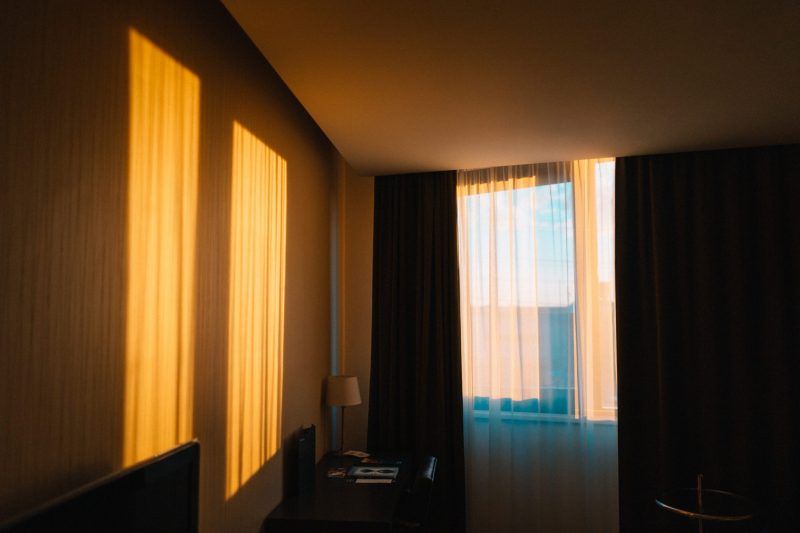Valances can be easily confused with swags, scarves, and cornices. Regardless, learning how to hang curtains with valance and similar decorative features can definitely add a little something to your curtain’s aesthetic appearance. In this article, we will show you how to hang curtains with valance the right way.

Give your living rooms and bedroom windows a bit of privacy while leaning towards style. Luckily, you can give your window treatments an additional flair with a touch of color and texture that complements your curtains perfectly.
Hang curtains with valance using double brackets and experiment with curtain layerings and other design techniques. Select from numerous valance styles that will help make different dramatic effects on your interior.
What are valances?
A valance falls under the category of ornamental window treatments. Unlike regular curtains, it does not cover the entire window, perhaps not even half of the pane. Rather, it covers the top fourth of the pane, adding texture and improving the aesthetic appeal.
Hanging curtains with valance
We can all agree that curtains already look good on their own. But I can assure you that this extra piece of decorative material will create a significant improvement in its aesthetic appeal. Luckily, you can achieve this visually appealing decoration in just a few easy steps when you learn how to hang curtains with valance.
Step 1: Get your materials ready.
Obviously, you will not be able to hang two types of window treatments using a single rod. Get yourself a pair of rods. You can use a decorative rod for sheer fabric since its lightweight material cannot conceal the rod.
Get yourself a double bracket similar to your regular curtain bracket, except it has two slots. You can buy two separate pairs of brackets, but one pair should extend four inches from the wall. The longer bracket will hold your valance rod.
Step 2: Install Hardware
If you already have curtains installed, then your brackets should be placed at a reasonable location. Replace your single brackets with the double brackets so that they can hold two rods at the same time.
For separate wall-mounting brackets, install your valance brackets just above the curtain rod. Make sure to measure and mark the placements to not end up with a misaligned bracket installment.
Step 3: Hang your curtain
Whether you’re using back tabs, ring clips, or other curtain hardware, this step is relatively the easiest part. Simply slip your curtain onto the rod and hang it on the rod bracket. For double brackets, your curtain rod should be placed at the slot closer to the wall. The same rule goes for separate wall-mounted brackets. Hang it at the slot closer to the wall.
Tip: Adjust your curtains
Before you hang your valence, make as many adjustments to your curtains to achieve a neat and well-tailored appearance. You can already iron or steam it to get rid of the visible wrinkles. Style the curtain as it is.
Step 4: Hang your valence
Now that your curtains are dolled up and neatly spread apart, you can move on to your valence. Slip the valence onto the rod, and hang it on the corresponding bracket. Make the manual adjustments until you’re satisfied with its placement.
Types of valances
You might be wondering how on earth can adding a piece of extra fabric improve your window treatments? Well, valances actually come in many different styles. You can have a box-pleated valance for a classic design perfect for traditional bedroom styles.
Simple valances are probably one of the most common in most households. Designers use them to layer over window treatments to achieve a causal decoration. Don’t be afraid to experiment with different types of designs. Just make sure that you are considering the curtain’s design.
How to pair curtains and valances
A valance is generally a term used to describe window treatments covering the upper part of the pane. So you should be glad to hear that valances don’t always have to go with curtains. In fact, you can find perfect matching designs that put together valances with blinds, shutters, and shades.
One popular and pretty simple way to match curtains and valances is through using the same material. It is a pretty classic design technique that establishes a sense of continuity from top to bottom.
But if you want to be a bit more dynamic, there are tons of ways to mix and match different materials, colors, and styles in a way that both elements are complementing. Don’t be afraid to go a little bit over your comfort zone.
You can typically pair traditional wooden blinds or roman shades with cotton fabric valances in fabric and style. The lightweight materials frame the hardness of the wood. It softens up the appearance while giving your room a sufficient amount of privacy.
You can also use materials that are complementing one another. For instance, light sheer valances can go with medium-heavy materials. Valances are an excellent way to add details and formality to a particular design.
Summary
Learning how to hang curtains with valances is one of the many steps to take when exploring the art of window treatments. There are many endless possibilities to mix and match different materials, designs, colors, and other elements.
Overall, you designing curtains and pairing them with casual or formal decorative window treatments such as swags and valences will eventually pay off, especially if you are fond of maintaining a well-kept room.
